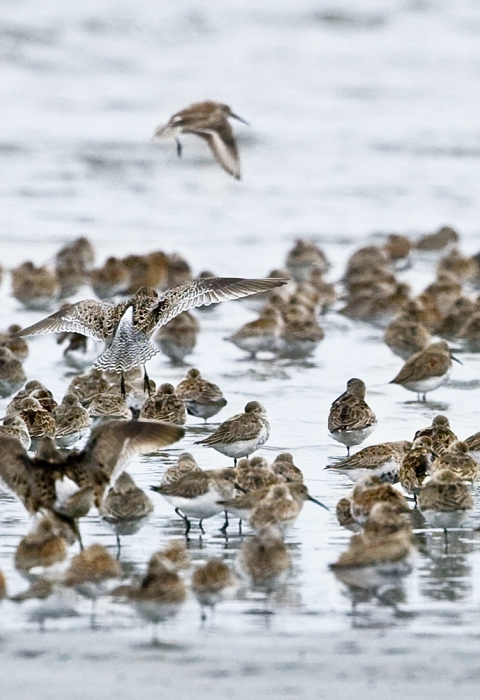About Us
The first evidence of interest in protecting the mudflat habitat in Bowerman Basin was in 1985, at the International Association of Fish and Wildlife Agencies Conference. A proposal to establish a Western Hemisphere Sister Reserve System was made to protect shorebird populations. The concept was developed to identify essential migratory shorebird habitats in the western hemisphere, supporting 48 species with an estimated population of 10 to 20 million birds. Bowerman Basin at Grays Harbor, Washington, was among the sites proposed for inclusion in the Sister Reserve System. A grassroots effort, and support from the Port of Grays Harbor who administered Bowerman Basin at the time, resulted in the establishment of Grays Harbor National Wildlife Refuge in 1988. The first parcel of land was included in 1990. Currently, 1,408 acres of the 1,851 acres within the approved boundary have been acquired.
Our Mission
The mission of the National Wildlife Refuge System is to administer a national network of lands and waters for the conservation, management and, where appropriate, restoration of fish, wildlife, and plant resources and their habitats within the United States for the benefit of present and future generations of Americans.
Every national wildlife refuge national wildlife refuge
A national wildlife refuge is typically a contiguous area of land and water managed by the U.S. Fish and Wildlife Service for the conservation and, where appropriate, restoration of fish, wildlife and plant resources and their habitats for the benefit of present and future generations of Americans.
Learn more about national wildlife refuge was created for a special purpose. Some were created to protect migratory birds, others to protect threatened or endangered species or unique habitats, while others fulfill another special purpose. All activities allowed on refuges must be evaluated to make sure they will not conflict with the reason the refuge was founded. Grays Harbor National Wildlife Refuge was established with the following purposes:
- Conserve fish and wildlife populations and their habitats, including those of western sandpiper, dunlin, red knot, long-billed dowitcher, short-billed dowitcher, other shorebirds, and other migratory birds, including birds of prey;
- Fulfill international treaty obligations of the United States with regard to fish and wildlife and their habitats;
- Conserve those species known to be threatened with extinction;
- Provide an opportunity, consistent with the purposes set forth in paragraphs (1), (2), and (3), for wildlife-oriented recreation, education, and research (Grays Harbor National Wildlife Refuge Act);
- "...for the development, advancement, management, conservation, and protection of fish and wildlife resources..." 16 U.S.C. 742f(a)(4);
- "...for the benefit of the United States Fish and Wildlife Service, in performing its activities and services. Such acceptance may be subject to the terms of any restrictive or affirmative covenant, or condition of servitude..." 16 U.S.C. 742f(b)(1), Fish and Wildlife Act of 1956.
Our History
Significant Dates
Aug. 19, 1988 - PL 100-406, the Grays Harbor National Wildlife Refuge Act, was passed by Congress and President Ronald Reagan.
Aug. 29, 1990 - The first acquisition of land (68 acres) to establish Grays Harbor National Wildlife Refuge.
March 1995 - Grays Harbor Estuary designated as a Western Hemisphere Shorebird Reserve Network Site of Hemispheric Significance in the Pacific Flyway. The estuary is a major staging area for migrating shorebirds on the Pacific Flyway, visited by over 500,000 shorebirds during spring and fall. Grays Harbor is one of four Shorebird Reserve sites in Washington State.
Other Facilities in this Complex
Grays Harbor National Wildlife Refuge is managed as part of the Nisqually National Wildlife Refuge Complex. A National Wildlife Refuge Complex is an administrative grouping of two or more refuges, wildlife management areas, or other refuge conservation areas that are primarily managed from a central office location. Refuges are grouped into a complex structure structure
Something temporarily or permanently constructed, built, or placed; and constructed of natural or manufactured parts including, but not limited to, a building, shed, cabin, porch, bridge, walkway, stair steps, sign, landing, platform, dock, rack, fence, telecommunication device, antennae, fish cleaning table, satellite dish/mount, or well head.
Learn more about structure because they occur in a similar ecological region, such as a watershed or specific habitat type, and have related purposes and management needs. Typically, a project leader or complex manager oversees the general management of all refuges within the complex. Refuge managers are responsible for operations at specific refuges. Supporting staff, composed of administrative, law enforcement, refuge manager, biological, fire, visitor services, and maintenance professionals, are centrally located and support all refuges within the complex.
Other refuges in the Nisqually National Wildlife Refuge Complex include Billy Frank Jr. Nisqually National Wildlife Refuge, and the Black River Unit of Nisqually National Wildlife Refuge. The Refuge Complex headquarters is located at Billy Frank Jr. Nisqually Refuge in Olympia, Washington.
